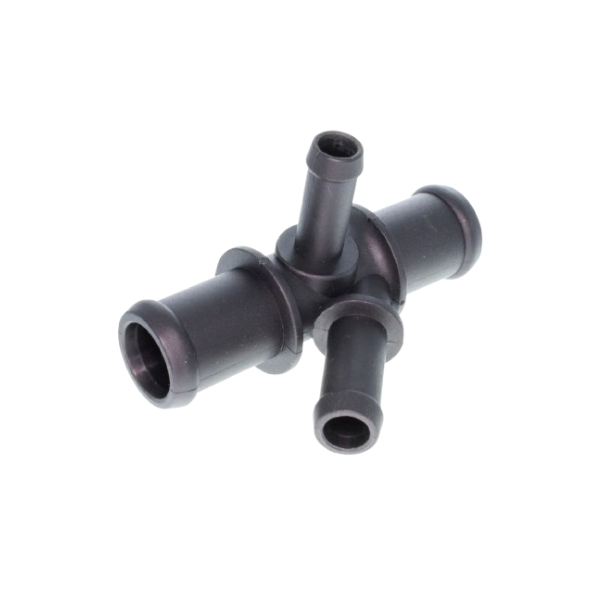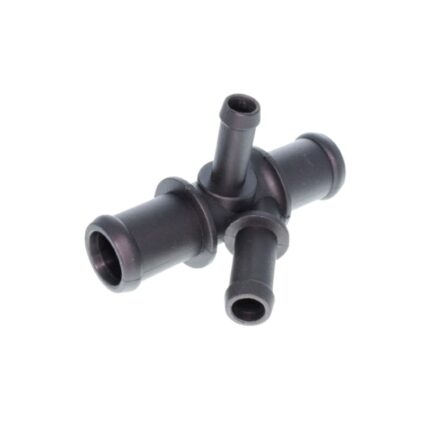Get AUDI A1/S1 2010-2018 Plastic Coolant Flange Distributor 1K0121087P in Kenya
The coolant flange distributor, often referred to simply as a coolant flange, is a critical component in a vehicle’s cooling system. It plays a key role in distributing coolant to various parts of the engine, ensuring optimal temperature regulation and preventing overheating. Understanding its design, function, types, benefits, maintenance, and replacement is essential for maintaining the efficiency and longevity of a vehicle’s engine.
Design and Function
Design:
A coolant flange distributor is designed to manage the flow of coolant through the engine and associated components. Its design typically includes:
- Flange Body: The main component, usually made of metal or high-strength plastic, that mounts to the engine block or cylinder head. It acts as a junction point for coolant distribution.
- Ports and Outlets: Various ports and outlets through which coolant enters and exits. These are connected to hoses and other parts of the cooling system.
- Gaskets and Seals: Rubber or silicone gaskets and seals that ensure a leak-proof connection between the flange and the engine or coolant hoses.
- Mounting Bolts: Bolts or fasteners used to secure the flange to the engine block or cylinder head.
Function:
The primary functions of a coolant flange distributor include:
- Coolant Distribution: Directs coolant from the thermostat or water pump to various parts of the engine, such as the cylinder heads and heater core.
- Temperature Regulation: Helps maintain optimal engine temperatures by ensuring that coolant flows efficiently throughout the engine.
- Leak Prevention: Provides a secure connection between different parts of the cooling system, reducing the risk of coolant leaks.
Types of Coolant Flange Distributors
1. Standard Coolant Flanges:
- Description: Basic flanges that provide essential coolant distribution functions. They are typically used in conventional engines.
- Advantages: Simple design and reliable performance for standard cooling requirements.
2. Thermostat Housing Flanges:
- Description: Combines the functions of a coolant flange and thermostat housing. It integrates the thermostat within the flange.
- Advantages: Streamlines the cooling system by consolidating components, which can reduce potential points of failure.
3. Heated Coolant Flanges:
- Description: Includes built-in heating elements or passages that help to prevent coolant freezing in cold weather.
- Advantages: Useful in colder climates to ensure that the cooling system functions effectively even in low temperatures.
4. Multi-Port Flanges:
- Description: Equipped with multiple ports and outlets to support complex cooling systems with various cooling channels and components.
- Advantages: Provides flexibility for advanced cooling systems and applications with multiple coolant pathways.
Applications
1. Automotive Engines:
- Description: Coolant flanges are widely used in automotive engines to manage the flow of coolant and maintain engine temperatures.
- Importance: Essential for preventing engine overheating and ensuring optimal performance.
2. Heavy-Duty Vehicles:
- Description: Used in trucks, buses, and other heavy-duty vehicles with larger and more complex cooling systems.
- Importance: Critical for managing coolant flow and temperature in high-load and high-temperature conditions.
3. Industrial Machinery:
- Description: Found in various types of industrial machinery with liquid-cooled engines or components.
- Importance: Helps maintain proper operating temperatures and prevent overheating in industrial applications.
4. Recreational Vehicles:
- Description: Utilized in RVs and boats with liquid-cooled engines or systems.
- Importance: Ensures reliable cooling and performance during recreational activities.
Benefits
1. Efficient Coolant Distribution:
- Optimized Flow: Ensures that coolant is evenly distributed throughout the engine, which helps in maintaining consistent temperatures and preventing localized overheating.
- Enhanced Performance: Supports optimal engine performance by preventing overheating and improving efficiency.
2. Leak Prevention:
- Secure Connections: Reduces the risk of coolant leaks by providing secure connections between different parts of the cooling system.
- Reduced Maintenance: Minimizes the need for frequent repairs or replacements due to leaks.
3. Temperature Regulation:
- Consistent Temperatures: Helps maintain engine temperatures within the optimal range, which is crucial for engine longevity and performance.
- Improved Safety: Prevents engine overheating, which can lead to severe damage or failure.
4. Integration with Cooling System:
- Streamlined Design: In cases like thermostat housing flanges, combines multiple functions into a single component, which simplifies the cooling system and reduces the number of parts.
Maintenance and Troubleshooting
1. Regular Inspection:
- Check for Leaks: Inspect the flange and surrounding areas for signs of coolant leaks. Leaks can indicate a failing gasket, seal, or flange.
- Examine Connections: Ensure that all hoses and connections to the flange are secure and in good condition.
2. Cleaning:
- Remove Debris: Clean the flange and surrounding area to remove any debris or buildup that could affect performance or cause leaks.
- Inspect Gaskets: Check gaskets and seals for signs of wear or damage. Replace them if necessary to ensure a proper seal.
3. Replacement:
- Signs of Failure: Replace the coolant flange if it shows signs of cracking, corrosion, or leaks. Common indicators include decreased coolant levels, engine overheating, or visible damage.
- Procedure: Replacing the coolant flange typically involves draining the coolant, removing the old flange, installing the new one with fresh gaskets, and refilling the coolant. Follow the manufacturer’s recommendations for proper installation and bleeding the cooling system.
4. System Checks:
- Coolant Levels: Regularly check coolant levels and top up as needed. Low coolant levels can indicate a leak or other issues in the cooling system.
- Temperature Monitoring: Monitor engine temperature gauges to ensure that the engine is operating within the normal temperature range.
Seasonal Considerations
1. Winter:
- Prevent Freezing: Ensure that the coolant is properly mixed with antifreeze to prevent freezing and potential damage to the cooling system.
- Check for Ice Buildup: Inspect the flange and related components for ice buildup or other cold-weather issues.
2. Summer:
- Monitor Temperature: Pay extra attention to engine temperatures during hot weather to ensure that the cooling system is functioning effectively.
- Inspect for Overheating: Check the flange and cooling system for signs of overheating, such as steam or abnormal temperature readings.
Follow us on Facebook for more parts.




